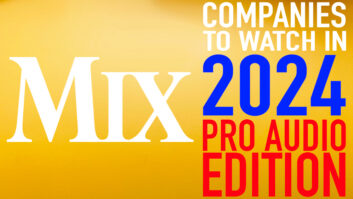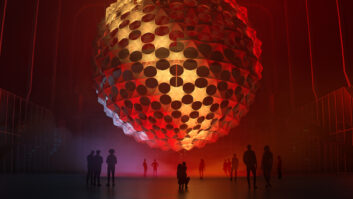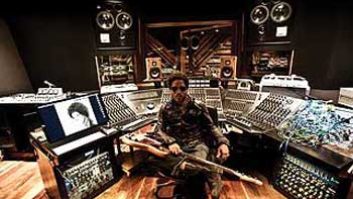Take the guy who used to run AIR Studios, add some of Europe’s top-name producers, a broadband audio transmission outfit and a few million pounds’ worth of custom-built facilities and you get a remarkable result — Sphere Studios, London’s newest studio complex.
Sphere is located in a converted laundry — which is an ideal environment, according to co-director Malcolm Atkin, formerly general manager at AIR Studios. “We were actually very lucky to have found an industrial building that had such a solid frame,” explains Atkin. “This is extremely important for a studio installation, and our foundations here are extremely strong. We’re only a few minutes outside the heart of London’s A&R community, and our transport links even include a local heliport.”
Atkin recounted the start of the project, with partner Francesco Cameli: “Frank had already bought the building with a view to putting his own studio into it, but it was really too big for a personal project. Luckily, we found each other at exactly the right moment and joined forces.” Funding for Sphere comes from a delicate balance of private money, the bank and the directors’ formidable reputations. Atkin points out that the mixing room’s first project — a Genesis DVD produced by Nick Davis — was a huge endorsement. “Even bank managers have heard of this band,” says Atkin. “We couldn’t have wished for a better start.”
The compact 10,000-square-foot site houses six production suites, a large tracking room, a 5.1 mix room, and a 5.1 mix and MIDI suite. Because Sphere makes the production rooms available as empty shells, producers can equip them exactly as they wish, and the multiformat connection system allows for an almost infinite variety of gear. All of the rooms are situated radially around a central machine room, a concept lifted from the broadcast industry. “We realized very early on that connectivity was the name of the game for a 21st-century studio,” Atkin explains. “Just because a producer or composer is working in a small space does not mean that they should be denied access to big facilities.”
Connections between each studio and the machine room include analog/digital tielines, CAT5 lines, MADI video links, 50-way control cables and optical ties. Also, 2MB broadband and ISDN 30 lines ran into the building at the start of the project. “We knew that if we were going to do this, we’d have to really go for it,” says Atkin. “This is the first real new studio complex to be built in London in a long time, and we wanted to make it as future-proof as possible.”
The entire design and build operation was carried out by Munro Associates, with Westwick Installation handling the audio systems installations. The technical system design was done by Sphere’s technical manager, Tom Schlum. Atkin notes that the complexity of the infrastructure called for extremely accurate and comprehensive planning. “I knew it was vitally important to have the complete picture before we started,” says Atkin. “I brought Tom [Schlum] to the project at a very early stage. He has done a superb job and created a very comprehensive design database for the complete system and for coordinating the installation.”
The 500-square-foot Studio One boasts a 19-foot ceiling and can accommodate 38 musicians in the main studio area. (There are also three independently floating isolation rooms.) The control room monitors (modified Dynaudio M4s) are soffit-mounted to preserve sightlines between the console and the booths and live area. Two-track machines are located in the control room, while conventional multitrack machines are located in the central equipment room.
The Sphere team has taken the unusual step of making its production rooms available on either short or long leases, and has already attracted some very high-profile clients. First to sign on was Chris Kimsey, a producer whose client list features the Rolling Stones, Johnny Hallyday, Killing Joke, Ash, The Chieftains, Soul Asylum and INXS. Kimsey’s all-digital suite (based around a Pro Tools system, Sony DMX-R100 console and KRK monitors) was the first to be installed at Sphere.
Kimsey says that the combination of having his own gear in a ready-built, networked environment is a great idea. “I hate moving from one studio to another as a project progresses,” he explains. “I like to be able to get to know a room, and also the people around me, and Sphere is a community, not just a studio. Especially with software-intensive systems, it’s so useful to have someone knowledgeable on hand all the time. Creatively, to be surrounded by other people in the same business as yourself is very productive.” Future plans at Sphere incorporate an exclusive communal lounge bar, which will further enhance the community feel.
Having six rooms that can be linked to each other and/or the tracking room is proving to be a major benefit. Sphere enjoys a constant revenue stream from producers like Kimsey and Pete Vettese, who have each leased a production room, while short-term clients are naturally inclined to use the adjacent tracking studio for acoustic instrumental parts and vocals. The multiroom design makes it easy to start a project in a production room or Studio One and finish it in the impressive mixing room, all without leaving the building.
Atkin is anxious to point out that the studio does not insist that its production room clients use the larger facilities. “Production suites like these are not new, but ours are unusual in that you could easily produce an entire album in them — thanks to the connectivity between rooms and equipment,” he says. “Of course, we’d like to think that they’ll give the big rooms a try, but the intention is that all the rooms will be busy in their own right. We’re not interested in putting barriers up.”
CONSOLES FOR EVERY TASTE
With three very different types of recording space available, Sphere offers something for every taste. “One of our hardest decisions to make was over consoles,” recalls Atkin. “When the time came to get down off the fence, we knew that we had to go with the most commercially viable option, provided that the audio quality was there.” The tracking room (Studio One) is equipped with a 72-channel Neve 88R, while the mixing room (Studio Two) has an SSL 9000 J. Studio Three contains an extensive keyboard selection and a 56-channel Euphonix CS3000. “The Neve is fitted with Encore automation and 36 remote mic preamps,” explains Atkin. “[For this console,] Neve used a very similar design to the Montserrat console they built for AIR, which has a brilliant sound. This time around, the control system runs under Windows NT, which means that it interfaces completely with our network and can be used from any of the production rooms, so our tenants will find it very easy to use.”
The SSL was chosen after extensive research into engineers’ and producers’ preferences, though Atkin expresses his disappointment with one important feature: “Even though the control room monitor pot is calibrated from 0 to 11 in true Spinal Tap style, I’m sure I asked for one that that went up to 12,” he says. On a more serious note, the console features the latest modifications from SSL, including 6-channel compressors and 5.1 alternate speaker-switching. “The mixing room is unique in the UK in being the first built for 5.1 surround sound from the ground up,” notes Atkin. “Most 5.1 rooms are old stereo rooms with more monitors in them. Here, even the walls are in surround.”
The Sphere team chose not to install permanent soffit-mounted monitors in the 5.1 room (Studio Two). “I’m sick to death of having big monitors that clients moan about and which can’t be moved,” he says. “The silly thing is that because the big monitors are not the producer’s choice, they only get used for five minutes a day, while the real mixing is done on the near-fields. I believe that film scoring mixers have the right approach — when you mix, do it for the most expensive, best-sounding system out there. It’s just not true that most people have poor quality hi-fi these days, so the technique is relevant in music as well.”
For the SSL room, the freestanding monitor system is, by its nature, fluid. After experimenting with monitors from PMC and others, the Sphere design team selected Dynaudio C4s with custom bass cabinets. “We set up our own favorites, but if someone doesn’t like our choice, we will happily let them use their own monitors,” Atkin notes. “Everyone has their own opinions about monitors, and we don’t want to lose clients over one element of our installation.”
Outboard equipment choices were slightly more straightforward. “When we looked at what equipment each room should have, we put everything into three categories,” explains chief engineer Ben Georgiades. “These were absolute essentials, studio staples that everyone expects you to have, and then a big, long wish list.” Though not every item on his wish list was purchased, Georgiades was pleased to see a few “specials” added to the studio’s inventory. “Some things are best left to rental companies, but there are others that are almost impossible to find,” he notes. “Some [pieces of gear] are so well-thought-of that you end up paying considerably more at auction than they would have cost new.” Among the more venerable items in the racks are GML equalizers and an MXR phaser/flanger. As Georgiades points out, not every “classic” is old: “We have Manley Massive Passive EQs, and I don’t think I’ve ever heard a more musical piece of equipment except possibly the Fairchild, which we had at AIR,” he says.
I CAN SEE FOR MILES
Though Sphere’s studio specifications are top-notch, it is the company’s attitude toward the future of the record business that is most interesting. “For the moment, it’s important for us to be physically near to record companies,” says Atkin. “These people still use bikes and couriers to move media around, yet I’m sure it won’t be long before the bulk of what is produced here is transmitted electronically, rather than committed to a reel of tape. This means, of course, that communication with the outside world is vital. We can’t afford to be just another stand-alone facility like so many others. There is a huge amount of trans-Atlantic business going on, with American artists working with British producers and vice versa. With the right communications, we can become the portal into London for clients who take this sort of international approach.”
While Atkin and his colleagues have all the studio experience anyone could wish for, they recognized that specialist talent was needed to optimize worldwide communications, and have entered into a deal with H2O, the London-based audio transmission and recording consultancy. H2O’s previous projects have included virtual overdubs for the likes of Mariah Carey and Coolio, and the company has contracted to provide ’round-the-clock access to the broadband technology that will allow Sphere’s remote clients to see and hear work in progress. In addition to providing the ISDN-based audio technology that allows collaboration in real time among musicians and producers who are thousands of miles away, H2O will maintain DolbyFax, APT and Musicam codecs, IP-based video links and MediaManager browser software, which is used by A&R personnel for keeping track of remote work in progress.
“Whether people choose to use this just as a file-exchange system, for instant approval from remote clients, or for recording an album on five continents at the same time doesn’t really matter,” concludes Atkin. “The important thing is that it will save an enormous amount of time and trouble for everyone, and make so many more exciting international projects possible. Then we really will have shrunk the globe.”
Mike Mann is a freelance writer living in England.




